Canon Digital Rebel XT: Hardly an Entry-Level DSLR
by Stephen Caston on May 3, 2005 12:05 AM EST- Posted in
- Digital Camera
General Image Quality
For these pictures, the camera was reset to its factory default setting. Then, it was set to its highest quality recording setting. The pictures were then taken in Aperture-priority mode with Auto WB unless stated otherwise. Portrait-style images have been rotated automatically with the "Auto rotate" feature on the 350D. Click on a thumbnail to view the full-size image. All images were shot with Aperture-priority mode, Parameter 2, and sRGB.  16-35mm ISO 100, 1/250th, f/4.0 Click to enlarge. |
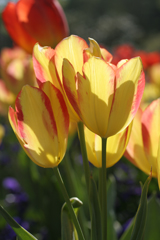 50mm Macro ISO 100, 1/800th, f/5 Click to enlarge. |
 28-135mm IS ISO 200, 1/320th, f/8 Click to enlarge. |
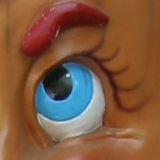 |
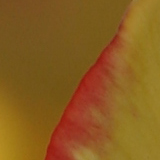 |
 |
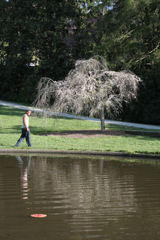 28-135mm IS ISO 100, 1/250th, f/4.5 Click to enlarge. |
 16-35mm ISO 800, 1/200th, f/2.8 (Fluorescent WB) Click to enlarge. |
 16-35mm ISO 1600, 1/100th, f/5.0 Click to enlarge. |
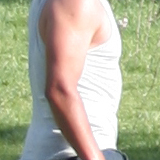 |
 |
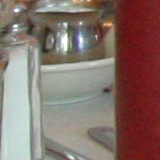 |
In the first sample image, we found the 350D capable of reproducing very impressive details when matched with a top quality lens. The image has a cool color cast, which resulted from the Auto WB setting. Had we selected the Shade or Cloudy setting, the colors would have been much more accurate. In samples 2 and 3, we want to point out that images right out of the camera will most likely be on the soft side with relatively low saturation. If a "punchier" image is desired right out of the camera, you will have better luck selecting a custom parameter in order to tweak the sharpness, contrast, etc.
In the fourth sample, we wanted to take a look at the 350D's dynamic range. Although this is a rather extreme example, the 350D has clearly overexposed the information in our crop. Avoiding overexposed subjects is an ongoing struggle with digital cameras and one way to deal with this is to shoot in RAW mode. More than likely, if this image had been taken as a RAW file, the highlight detail could have been saved. Sample 5 is another reason to shoot in RAW mode. Although we were satisfied with the detail and image quality, the colors aren't quite right. We set the camera to Fluorescent WB, but really, there was a mixture of fluorescent, tungsten, and indirect sunlight. In tough situations like this, it is best to shoot in RAW mode because you can easily adjust the WB later. Finally, in the last sample image, the 350D proves that it can take very detailed images even at ISO 1600. It is in shots like this that the 350D really benefits from the low-noise DIGIC II image processor. Overall, we are extremely impressed with the image quality of the 350D. Having shot with both the 20D and the 350D, we don't feel that there is any noticeable difference with regard to image quality other than the extra ISO option on the 20D (ISO 3200).
Long Exposure
 16-35mm ISO 100, 20 sec., f/7.1 Noise Reduction Off Click on images to download. |
 16-35mm ISO 100, 20 sec., f/7.1 Noise Reduction On Click on images to download. |
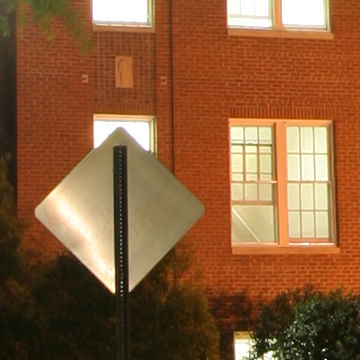 Hold mouse over image. |
|
In comparing the two 20 sec. exposures above with and without noise reduction, we saw virtually no difference in the level of noise. We were extremely impressed with the image quality and couldn't find any stuck pixels throughout either image. The only difference between the two images that we could observe was an incredibly small difference in sharpness. The image taken without noise reduction appeared to be a tiny bit sharper than the image taken with noise reduction. You'll have to forgive the lopsided-ness of our night samples. We drove 110 miles to Greenville only to realize that we left our tripod at home.










27 Comments
View All Comments
6000SUX - Sunday, May 8, 2005 - link
Thanks for a great review. Based on this one, I went to some other sites like dpreview.com, checked out lots of sample pictures etc. against competitors like the D70 and decided to take the plunge. All I can say is, this camera's fantastic. It's easy even for a relative newbie like me to get up to speed and take really great pictures.Now I have a great camera with which to take pictures of my first child. Thanks again.
stephencaston - Thursday, May 5, 2005 - link
#23, Unfortunately, since the digicam section is still relatively new, we don't have a lot of places to get products right now (lenses). We have been able to do Canon SLR reviews simply because we already have lenses. Don't worry, we are planning on covering the new Nikon DSLRs as soon as we can get them.Stephen
sgtroyer - Thursday, May 5, 2005 - link
I've got to add to the calls for a Nikon DSLR review. It's a pretty glaring omission given the reviews of the Canon 300D, 20D, and 350D, but no Nikon. The D70 is a fantastic camera, far better than the 300D for marginally more money. The D50 will provide even better value. Isn't reviewing only Canon DSLRs sort of like reviewing only Nvidia GPU's or Intel processors?stephencaston - Thursday, May 5, 2005 - link
Keep in mind that this isn't a "real world" battery test. We literally sat down with the camera and took 3,818 frames in one session.Ender78 - Thursday, May 5, 2005 - link
The battery life stated here seems to be a little off. I will have to test, but I dont believe my camera has anywhere close to the stated battery life.gplracer - Wednesday, May 4, 2005 - link
Nice review. I decided on the 20D over the 350 because of the size, feel, and the controls. The wheel in the back of the 20D is so much better than the controls on the 350. I am sure picture quality is close.brownba - Wednesday, May 4, 2005 - link
even my sd300 has this 'rattle.'i too assume it's for determining position.
that's the coolest thing - when you're in clock mode, if you swiftly move the camera, it will change the color of the clock.
shuttleboi - Tuesday, May 3, 2005 - link
From what I've read, the viewfinder on the XT is even smaller than the tiny one I have on my 300D. I also own a Canon film SLR, and the viewfinder in that is freaking huge compared to the one in my 300D. When you have a wide-aperture lens (larger than f2.8), then you will want a large viewfinder to see if you are focusing correctly, otherwise it is very easy to get the focus plane locked with the narrow depth of field.shuttleboi - Tuesday, May 3, 2005 - link
#13: if the XT is like my 300D, then that rattling sound is the part of the camera that determines if you are holding the camera vertically or horizontally. It is normal.STaSh - Tuesday, May 3, 2005 - link
No idea...I have a 20d.